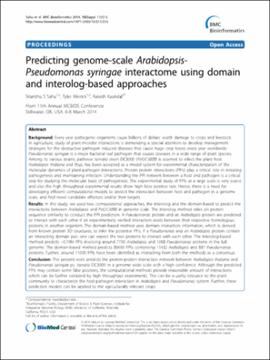| dc.contributor.author | Sahu, Sitanshu S. | |
| dc.contributor.author | Weirick, Tyler | |
| dc.contributor.author | Kaundal, Rakesh | |
| dc.date.accessioned | 2018-11-09T21:10:53Z | |
| dc.date.available | 2018-11-09T21:10:53Z | |
| dc.date.issued | 2014-10-21 | |
| dc.identifier | oksd_sahu_predictinggenom_2014 | |
| dc.identifier.citation | Sahu, S. S., Weirick, T., & Kaundal, R. (2014). Predicting genome-scale Arabidopsis-Pseudomonas syringae interactome using domain and interolog-based approaches. BMC Bioinformatics, 15(Suppl 11), Article S13. https://doi.org/10.1186/1471-2105-15-S11-S13 | |
| dc.identifier.uri | https://hdl.handle.net/11244/302068 | |
| dc.description.abstract | Background: Every year pathogenic organisms cause billions of dollars' worth damage to crops and livestock. In agriculture, study of plant-microbe interactions is demanding a special attention to develop management strategies for the destructive pathogen induced diseases that cause huge crop losses every year worldwide. Pseudomonas syringae is a major bacterial leaf pathogen that causes diseases in a wide range of plant species. Among its various strains, pathovar tomato strain DC3000 (PstDC3000) is asserted to infect the plant host Arabidopsis thaliana and thus, has been accepted as a model system for experimental characterization of the molecular dynamics of plant-pathogen interactions. Protein-protein interactions (PPIs) play a critical role in initiating pathogenesis and maintaining infection. Understanding the PPI network between a host and pathogen is a critical step for studying the molecular basis of pathogenesis. The experimental study of PPIs at a large scale is very scarce and also the high throughput experimental results show high false positive rate. Hence, there is a need for developing efficient computational models to predict the interaction between host and pathogen in a genome scale, and find novel candidate effectors and/or their targets. | |
| dc.description.abstract | Results: In this study, we used two computational approaches, the interolog and the domain-based to predict the interactions between Arabidopsis and PstDC3000 in genome scale. The interolog method relies on protein sequence similarity to conduct the PPI prediction. A Pseudomonas protein and an Arabidopsis protein are predicted to interact with each other if an experimentally verified interaction exists between their respective homologous proteins in another organism. The domain-based method uses domain interaction information, which is derived from known protein 3D structures, to infer the potential PPIs. If a Pseudomonas and an Arabidopsis protein contain an interacting domain pair, one can expect the two proteins to interact with each other. The interolog-based method predicts ~0.79M PPIs involving around 7700 Arabidopsis and 1068 Pseudomonas proteins in the full genome. The domain-based method predicts 85650 PPIs comprising 11432 Arabidopsis and 887 Pseudomonas proteins. Further, around 11000 PPIs have been identified as interacting from both the methods as a consensus. | |
| dc.description.abstract | Conclusion: The present work predicts the protein-protein interaction network between Arabidopsis thaliana and Pseudomonas syringae pv. tomato DC3000 in a genome wide scale with a high confidence. Although the predicted PPIs may contain some false positives, the computational methods provide reasonable amount of interactions which can be further validated by high throughput experiments. This can be a useful resource to the plant community to characterize the host-pathogen interaction in Arabidopsis and Pseudomonas system. Further, these prediction models can be applied to the agriculturally relevant crops. | |
| dc.format | application/pdf | |
| dc.language | en_US | |
| dc.publisher | BioMed Central | |
| dc.rights | This material has been previously published. In the Oklahoma State University Library's institutional repository this version is made available through the open access principles and the terms of agreement/consent between the author(s) and the publisher. The permission policy on the use, reproduction or distribution of the material falls under fair use for educational, scholarship, and research purposes. Contact Digital Resources and Discovery Services at lib-dls@okstate.edu or 405-744-9161 for further information. | |
| dc.title | Predicting genome-scale Arabidopsis-Pseudomonas syringae interactome using domain and interolog-based approaches | |
| osu.filename | oksd_sahu_predictinggenom_2014.pdf | |
| dc.description.peerreview | Peer reviewed | |
| dc.identifier.doi | 10.1186/1471-2105-15-S11-S13 | |
| dc.description.department | National Institute for Microbial Forensics and Food and Agricultural Biosecurity | |
| dc.description.department | Biochemistry and Molecular Biology | |
| dc.type.genre | Article | |
| dc.type.material | Text | |
| dc.subject.keywords | plant-pathogen interactions | |
| dc.subject.keywords | bioinformatics | |
| dc.subject.keywords | unsupervised learning | |
| dc.subject.keywords | arabidopsis | |
| dc.subject.keywords | pseudomonas syringae | |
| dc.subject.keywords | interactome | |
| dc.subject.keywords | computational prediction | |
